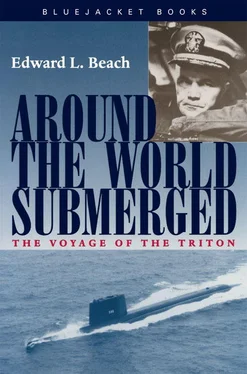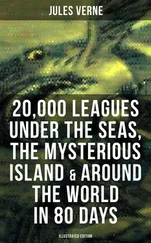Conning her carefully, we eased Triton out into the stream and pointed her fair down the Thames River. Once clear, I gave the order “all ahead two-thirds,” and our great ship increased speed as she progressed down the river into Long Island Sound.
It was just after daybreak as we passed New London Light at the mouth of the river, and I beckoned to Floyd W. Honeysette, who had the quartermaster watch on the bridge. “Keep a sharp lookout to starboard on the first white house on the point,” I told him. “Let me know if they flash a light or make a signal.”
In a few moments, Honeysette reported that there was no light, but that someone leaning out of a second-story window was waving a red cloth. I directed him to return the compliment by flashing the ship’s searchlight, and this is how Dr. and Mrs. Tage M. Nielsen of New London, friends of many years, became the first persons with whom Triton exchanged signals. Later, I learned the red fabric was a new nylon petticoat belonging to Claudia Nielsen, and that she had made a special reveille in our honor.
There is something about going to sea for the first time in a ship on which you have labored long and hard that is like no other experience. Triton was already quick with life, but when we got her past Race Rock and rang for flank speed for the first time, our spirits soared with her tremendous response.
Trigger had been a good ship, outstandingly effective in her business, and Tirante a ruthlessly efficient one, with spirit and stamina besides. Piper’s qualities had remained largely unknown because she had had no chance to win her spurs in combat, but Amberjack had originality and dash. Trigger II, the first of an entirely new class of submarines to enter service, had been a failure because of bad engines. Only recently, approximately eight years after construction and at last fitted with brand new engines, she was showing her mettle as one of the finest diesel submarines in the force. Salamonie, my previous ship, oldest of them all except the never-forgotten Lea, though still a “producer” was nearly worn out from years of strenuous operation.
But none of these, I knew instantly, had the heart and drive of Triton. The way she leaped ahead when the power was applied made my heart leap, too; we could actually feel the acceleration as we gave her the gun. Water streamed by us on both sides; spray pelted our faces on the bridge and more splashed against its forward edge into thousands of flying, multicolored droplets in the early morning sunshine.
We headed her southeast into Block Island Sound and toward Montauk Point, aiming her foaming bow directly toward the morning sun.
In an unbelievably short time we had roared past Cerberus Shoals. Shortly afterward, as we changed course to due south, Montauk Point came up to starboard, and soon we were free on the ocean where two years ago I had steamed with Salamonie and where fifteen years ago German submarines were on the prowl. I kept calling down below for reports of our speed, must have grinned like a small boy each time I heard the figures.
Once clear of the shoal water, I turned the deck over to Brodie and went below to see for myself how things were going. Everywhere about me was an air of relaxed, delighted intensity. Triton was handling almost unbelievably well. There were nothing but smiles in the control room, torpedo rooms, and galley. In the machinery spaces, men were doing their routine tasks with a light in their eyes and a lilt in their voices I had never seen before. One might have imagined we were an orchestra, playing on a new and greater instrument. This air of confident optimism pervaded the ship, and as I listened to the reports coming and going, the watch reliefs turning over, the reports of log entries and the various other minutiae that go into operating a ship, I knew that we had a crew and a ship equal to the best anyone had ever had the good fortune to command. Except for a handful of “boot seamen,” we were all veterans; our first hours under way had been going so smoothly one might have surmised our crew had been working together for years.
Even taciturn Admiral Rickover, who rarely expressed pleasure with anything (holding, I suspect that to do so might cause his underlings to relax when they should be working harder than ever), was forced to admit that he had never witnessed a more successful beginning to a set of trials. I caught a hint of a smile on his face as I sought him out in the forward engine room.
“Admiral, the water will be deep enough to dive very shortly, and with your permission we’ll go ahead and take her down as originally scheduled.”
Admiral Rickover nodded. While not exactly deafening, the roar of machinery was a high-pitched symphony composed of many different sounds from hundreds of pieces of machinery, all operating in a well-ordered cacophony of rhythm. To me, it was sheer music. Music it must have been to him, too, even though I could detect no visible sign.
I left the engine room and proceeded aft through the remaining engineering spaces, finally reaching the after torpedo room. There, all was calm except for the noise of two huge propellers whirling away just outside. I listened to them carefully. It was hard to realize that they were only a few feet from me, spinning with violent energy, driving water aft at an unprecedented speed and putting more horsepower into the ocean than any submarine had ever done. I could feel the induced vibration shaking the entire after structure of the ship. The noise of the propellers and the roar of the water as it raced past our hull were almost as loud as the machinery a few compartments forward.
“Do you think you could sleep through this, Rowlands?” I asked the husky First Class Torpedoman’s Mate in charge of the after torpedo room.
Rowlands grinned. “You can sleep through anything if you’re tired enough, sir, but it sure is noisy.”
“She’ll quiet down a lot when we dive,” I pointed out.
Rowlands agreed. “But we’ll have to go pretty deep, Captain, to quiet down them spinning wheels with all that power.”
He was right. The deeper you go, the less noise your propellers make, but the bigger they are and the faster they spin, the more noise they make. Triton ’s propellers, eleven feet in diameter, turning far faster than any other submarine’s, could not avoid making noise at their present shallow depth. But, of course, no other submarine could go as fast on the surface as Triton ; when we slowed down to comparable speeds or when we submerged, the chances were that our ship would be as quiet as the others—perhaps quieter.
It was nearly time to dive. I hurried forward. Lieutenant Tom Thamm, Triton ’s Diving Officer, was already at his station with his number one diving crew. This entire group had trained together for several months at the submarine dive simulator at Electric Boat and at another, fancier, one in the Submarine Base; but, of course, this was the first opportunity for them actually to dive the ship.
They were, naturally, somewhat keyed up. The weights in a submarine must be so balanced that when she fills her main ballast tanks the ship will be in precisely neutral buoyancy. Otherwise, she would not be controllable. Naturally, as stores or torpedoes are put aboard, consumed, fired, or unloaded, there are changes in internal weights. These are compensated for by the bow and stern trimming tanks, and by two auxiliary tanks located amidships. These four tanks are known as “variable tanks,” because the amount of water they contain may be varied. This can be done without danger of rupture due to internal or external pressure. The “ballast tanks,” by contrast, are always open at the bottom, are empty for buoyancy when the ship is surfaced, and must be fully flooded to dive her. One of the trickiest problems in designing a submarine is to calculate the weights and the volumes so that, with all conceivable weights out of the ship, it is still possible to put enough water into the variable tanks to achieve neutral buoyancy. Conversely, she must be designed so that with maximum weight on board, enough water can be pumped out to restore her to neutral buoyancy. (Ballast tanks cannot be used for this, despite the misleading name, for they must always be fully flooded when submerged. Since they are never under any pressure differential, they are lightly constructed, unlike the extremely rugged variable tanks.)
Читать дальше












